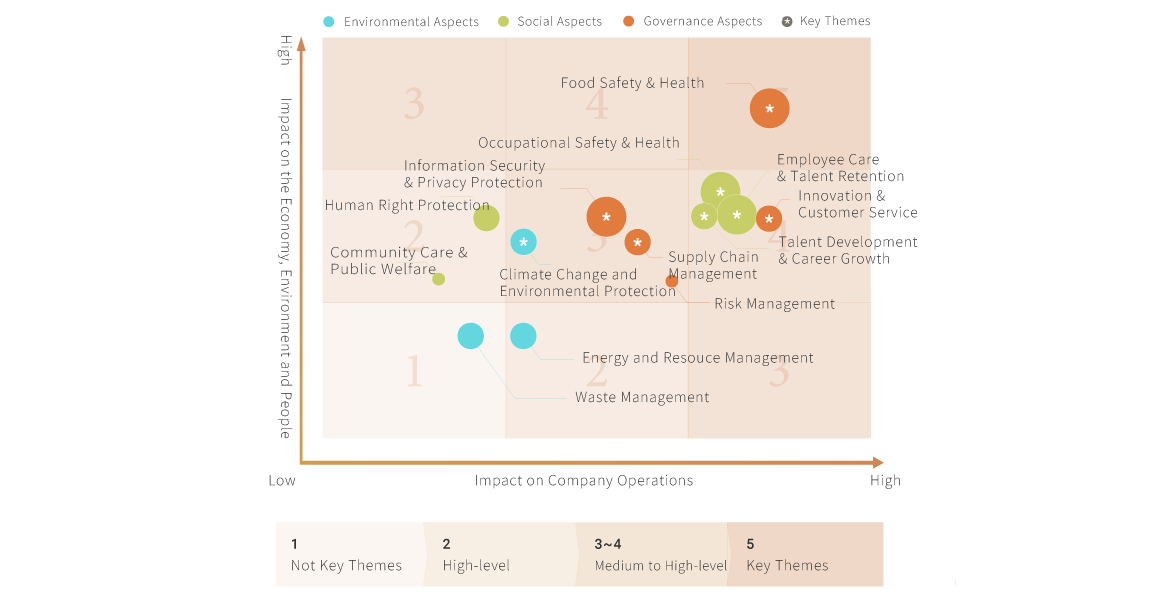For the 2024 list of material topics, a total of 156 survey responses were collected to screen the following 14 topics related to corporate governance, social, and environmental issues, and to analyze and quantify stakeholders' levels of concern regarding these topics. Responsible units discussed and ranked the potential impacts of each topic on the economy, society, and the environment. Based on a materiality matrix analysis, the Sustainability Committee sub-group conducted further discussions, and the final review, adjustment, and confirmation were performed by management, ultimately identifying eight highly material topics.
Silks Hotel Group conducted its sustainability materiality assessment in accordance with GRI 3: Material Topics 2021, following the process outlined below:
Identifying Issue Questionnaire
The identification of material topics is based on the list of material issues from recent years, adjusted according to current sustainability trends. In addition to considering the potential impacts of the company's products on the economy, society, and environment, the process also takes into account industry concerns as well as the actual needs and expectations of stakeholders. This ensures that the list of topics reflects materiality, completeness, and inclusiveness.
Identifying Material Topics
Through questionnaire analysis, the level of stakeholder concern for each issue was assessed, along with the potential risks and opportunities these issues may bring to the company's operations and sustainability strategies. Each responsible unit further evaluated the potential impacts of the issues on the environment, society, and economy, as well as their implications for internal operations. Based on these assessments, the issues were prioritized and materiality was determined.
Confirming Material Topics
The preliminary identification and prioritization results were submitted to the management for review and confirmation to ensure alignment with the GRI principles of materiality, completeness, and stakeholder inclusiveness. Based on this process, the company defined the scope and boundaries of each material topic in terms of its internal and external impacts. These results serve as the foundation for formulating strategic directions and response measures and are disclosed in the annual report.
Review of Completeness
The scope of the sustainability report is based on the identified material topics, their boundaries, and the reporting period, ensuring that all material issues are comprehensively disclosed. The final report is reviewed and validated jointly by the Sustainability Committee and relevant responsible units to ensure the information is accurate, complete, and reliable.
A total of 156 responses were collected for the 2024 Material Topics Survey. The company, based on the European Union's advocated "Double Materiality" principle and the GRI 3 (Material Topics 2021) standards, analyzed and quantified stakeholders' levels of concern regarding various sustainability issues to identify material topics. Each responsible unit evaluated and ranked the potential impacts of these topics on the economy, society, and the environment, as well as their effects on the company's internal operations, and conducted analysis and discussions based on the evaluation results. After review by the Sustainability Committee sub-group, the preliminary identification results were submitted to management for final review, adjustment, and confirmation. Certain material topics required for regulatory compliance or practical disclosure purposes were also included within the scope of material topics. Ultimately, eight highly material sustainability topics were identified as the key disclosure topics for this report. By focusing on the core issues of concern to stakeholders, the company aims to more effectively advance its sustainability strategy, strengthening corporate resilience and sustainability performance.
Materiality Analysis Matrix
The X-axis represents the impact on company operations, while the Y-axis represents the impact on the economy, environment, and people. Each axis is weighted on a scale of 1 to 5. The size of the bubble indicates the level of concern among stakeholders.

